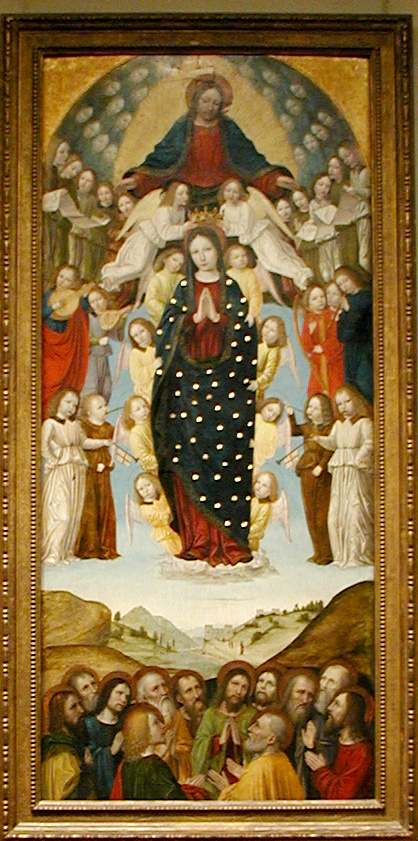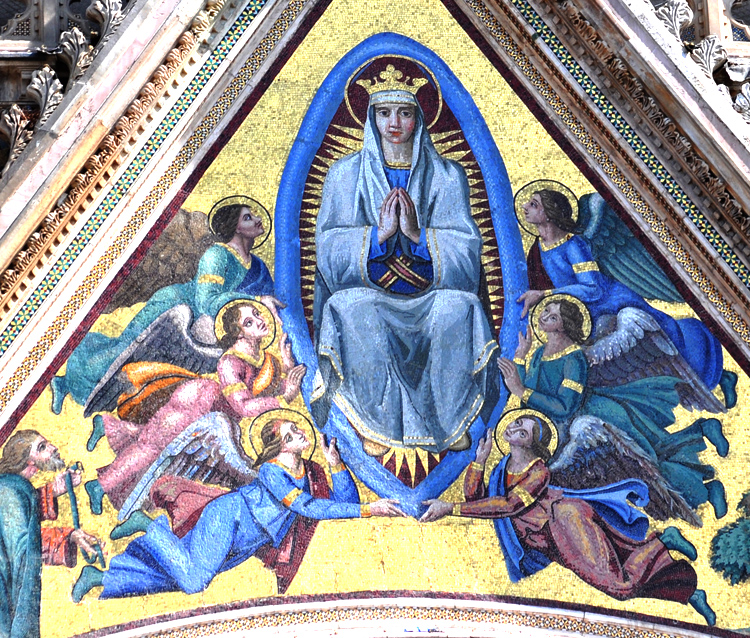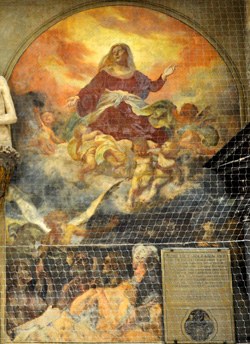Assumption images are especially popular in the tympana of Gothic cathedrals, where they are often in a second register, above the Dormition and below the Coronation (example). In paintings the Assumption is usually treated separately from the other two events, although Peter Candid merged it eloquently with the Coronation in this canvas.
THE FIGURE OF MARY
In the images of the Assumption, Mary is not often seen being actually lifted from her sepulcher. One exception, a Carraci Assumption, presents a hefty Mary who looks as if she would be hard to lift, in order to visualize the message that this is a real human body. Tintoretto obtains a similar effect in his Scuola di San Rocco Assumption by having one of the lifting angels grimace under the weight of the body.But usually we see a more otherworldly Mary on her way up toward Heaven. In the 13th to 15th centuries it is common to show angels lifting her aloft in a mandorla, as in the second picture at right and this tympanum from Croatia. The angels correspond to the "great multitude of angels keeping her company" described in the Golden Legend (Ryan, II, 82). Sometimes the mandorla has a cloud base. From the 15th century onward the images are more and more likely to show Mary rising on a cloud that angels are helping to lift (example). Some images leave out the Apostles and the scene below, and all we see is Mary with some putti (example). Her hands are often pressed together in prayer, as in the first and second pictures at right. Sometimes the arms are extended, as in the third picture at right, or less commonly held across the breast, as in this one. Many artists have her garments flutter briskly in the wind (example), perhaps influenced by St. Germanus's remark that a "sudden wind" swept her winding sheet up into the sky so that it "was seen moving like a swift cloud."2 (In the Rubens painting at right the winding sheet flutters above Mary's head.)
In most of Europe it is rare for an Assumption to picture Mary standing on a crescent moon, which is associated with images of the Immaculate Conception. In Spain, however, the crescent is not uncommon (example). In Mexico too, a number of ancient statues of Mary standing on a crescent moon were identified for us by local informants as Assumptions. The one at Tlacolula uses the fluttering garments, cloud, and supporting angels characteristic of Assumption iconography. Another at Teitipac has all this plus a crown.
THE APOSTLES AT THE SEPULCHER
In John of Thessalonica's 7th-century account the Apostles returned to the sepulcher after three days and opened it to venerate the Virgin's body "but found only her grave-garments, for she had been taken away by Christ."3 In about 740 John Damascene's version added some details that would be important in the art:For three days a chorus of angels continued to sing above it [the sepulcher]. After the third day, when the angelic singing had ended, the Apostles…now desired to venerate the body that had borne God; and they opened the little tomb. But no trace of her all-blessed body could be found; and taking the winding sheets, which were filled with fragrance, they closed the tomb.4These two sources account for many of the details in subsequent images. The Apostles will be shown standing around the open sepulcher, either puzzled or looking up in awe. In later paintings the angelic singing will be pictured as angels playing instruments, as in this detail from Lippi's 1492 fresco. The fragrance that John Damascene mentions later develops into floral imagery in the Breviary and Mass for Assumption day,5 which in turn leads to images that feature a profusion of flowers in the sepulcher (example).
Some larger images of the Assumption may include one to three young women along with the Apostles example. These are the "three virgins" who John of Thessalonica and the Golden Legend say were present at the Dormition to wash Mary's body and prepare it for burial (Ryan, 80; Daley, 64).
ST. THOMAS AND THE VIRGIN MARY'S BELT
A number of images have Mary in Heaven giving her belt to St. Thomas below. In the Golden Legend's account St. Thomas arrived too late for the Assumption and refused to believe the Apostles' account until Mary's belt "came to him from the air." In a different account, The Passing of Mary, Thomas is saying Mass in India when he is miraculously transported to the Mount of Olives and given a vision of Mary ascending into Heaven. He cries out asking Mary to "make thy servant joyful through thy compassion," and she responds by casting down to him the "girdle with which the apostles had encircled the most holy body" when they placed it in the sarcophagus (image). He is then transported to Jehosaphat, where he informs the Apostles that Mary is no longer inside the sepulcher but has gone up to Heaven. It is they who disbelieve, until he shows them the belt.
Prepared in 2016 by Richard Stracke, Emeritus Professor of English, Augusta University. Revised 2016-09-07,09, 2018-02-17, 2019-04-02.
NEXT:
PART SIX, THE CORONATION OF THE VIRGIN
ALSO SEE PARTS:
1
2
3
4
5
7
8

Bergognone, late 15th / early 16th century (See description page)

Nebbia, 1350-90 (See description page)

This Assumption refers to the belief that Mary has a special concern for the souls in Purgatory. (See the description page.)
MORE IMAGES
- 12th century: A capital in Oviedo Cathedral.
- 14th century: In a fresco in Orvieto Mary stands in her sarcophagus and lifts her arms for Christ to take her.
- 1340: In Daddi's Assumption she gives Thomas the girdle with one hand and holds a book with the other.
- 15th century: Gozzoli, The Virgin Gives Her Girdle to St. Thomas.
- Circa 1410: Taddeo di Bartolo's unusual combination of Dormition and Assumption imagery.
- 1497: St. Thomas and the girdle are pictured in this panel of a triptych by Il Pastura.
- 1502-1504: Raphael, The Oddi Altarpiece.
- 1547-51: Roque de Balduque's sculpture of the Assumption in Cáceres, Spain, has Mary standing on a crescent moon.
- 17th century: An altarpiece in St. Florian's Abbey, Austria.
- 17th century (?): Rainaldi, Trastevere.
- 17th century: Andrea Camassei, in the Pantheon.
- 1630-31: Girolamo Cialderi, Madonna Assunta e San Crescentino, Urbino.
- 17th or 18th century: The beginning of the Assumption event is pictured in this painting in Vienna.
- 1719: In Antonio de Torres's The Assumption of the Virgin Mary and the Apostles have a vision of Mary herself in the Assumption.
- 1748: Duque Cornejo's relief of the Assumption, with one of the angels holding a monstrance.
- 19th/20th century: An apse painting in Canada.
- Undated, possibly 18th or late 17th century: A painting in Venice's San Zulián church includes details related to the Mass for the Dead that are common in Dormitions but not in Assumptions.
DATES
- Celebrated on August 15 in the West as the Feast of the Assumption, in the East as the Dormition.
RELEVANT MEDIEVAL AND EARLY CHRISTIAN DOCUMENTS
- Golden Legend #119: html or pdf
- Germanus of Constantinople, "Third Discourse on the Dormition," in Migne, Patrologia Graeca, XCVIII and Toal, IV, 418-424.
- John Damascene, "Second Oration on the Dormition," in Migne, Patrologia Graeca, XCVI and Toal, IV, 425-38.
- The Passing of Mary
- Daley, On the Dormition of Mary: Early Patristic Homilies.
ALSO SEE
NOTES
1 Pius XII, Munificentissimus Deus, ¶44. An overview of the ancient literature on this subject is in ¶¶16-37 of the same text; another can be found in this note on the Dormition page.
2 "Third Discourse on the Dormition," in Migne, Patrologia Graeca, XCVIII, and Toal, IV, 423.
3 The Dormition of Our Lady, ¶14: Daley, 67.
4 "Second Oration on the Dormition," in Migne, Patrologia Graeca, XCVI and Toal, IV, 437 (¶18). The Oration also mentions the angelic songs on pages 428 and 431-32 (¶3 and ¶11).
5 The first reading for the Mass on Assumption Day was a passage from Ecclesiasticus 24 including the lines, "I was exalted like a palm tree in Cades, and as a rose plant in Jericho: As a fair olive tree in the plains, and as a plane tree by the water in the streets, was I exalted. I gave a sweet smell like cinnamon. and aromatical balm: I yielded a sweet odour like the best myrrh" (Missale Romanum, 601, Douay translation). From the Breviary for the same day: "I saw her lovely as a dove ascending above the waters, and an indescribable fragrance was in her garments; and roses and lilies of the valley surrounded her as if on a spring day" (Breviarum Romanum, 991-92, my translation).